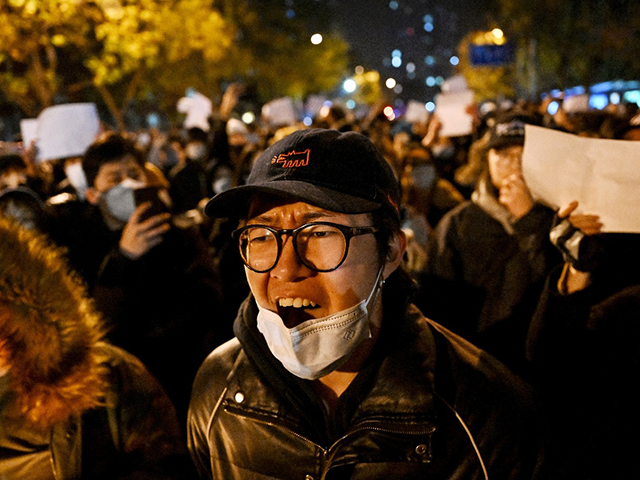The human rights organization Freedom House documented on Thursday a “new high” in the number of protests in China tied to the poor state of its economy, driven particularly by labor protests and acts of dissidence by mortgage holders hurt by the fall of the housing and real estate industry.
Freedom House published the latest update of its China Dissent Monitor on Thursday, a project in which it documents and verifies anti-government actions by Chinese citizens in the repressive communist state. The data is notable as Freedom House documented a consistent drumbeat of public anti-communist sentiment throughout 2023, even following the end of dictator Xi Jinping’s “zero-covid” tyranny, in which entire cities of millions of people were forced into house arrest and suspected Wuhan coronavirus patients were imprisoned in overcrowded, poorly managed quarantine camps.
The “zero-covid” policy prompted nationwide protests attracting thousands of people nationwide in November 2022 that many observers expected to end with the policy, which Beijing concluded shortly after those protests. The latest China Dissent Monitor report shows the end of “zero-covid” redirected public outrage to other issues, but did not end acts of unrest.
The China Dissent Monitor identified 707 “dissent events” in China in the third quarter of 2023. In total, the project “has collected 3,740 dissent events since June 2022.”
“The number of protests logged in August and September 2023 (461) is 1.5 times greater than the number recorded during the same period in 2022,” it observed.
“CDM [the China Dissent Monitor] has logged 461 protests linked to economic grievances in August and September 2023, 1.5 times greater than the number logged over the same period in 2022,” the report observed. “This pattern contrasts with news that China’s economic growth recovered in the third quarter.”
The Chinese Communist Party’s ongoing economic woes – from real estate developers in peril to fleeing foreign investment and long-term concerns about a birth rate collapse leaving the workforce depleted – were a significant driver of dissent in the country in the third quarter of 2023, the timeframe analyzed in the latest Freedom House report. China reported its first-ever decline in foreign direct investment in early November, an $11.8 billion drop in the third fiscal quarter of the year.
“Despite indications that China’s economic growth recovered in the third quarter of 2023, CDM data indicates that protests linked to economic grievances have hit the highest point since the project began in June 2022,” the report read. “Protesters have focused on issues like labor rights and unpaid wages, stalled construction projects and other housing disputes, fraud, debt, social benefits for retirees, and parents demanding refunds from shuttered tutoring companies.”
Xi Jinping appeared to imply concern over economic-related unrest in the country in August, delivering a sobering speech urging the public to have “patience” and continue to trust the Communist Party.
“We should first consider the size of the population and the large rural-urban development gap. We cannot be ambitious and unrealistic, but we cannot simply follow the beaten path. We should be patient and move forward in a steadfast manner,” he said at the time.
Over 60 percent of the 707 acts of dissent documented in the report published this week were related to labor unrest. The number of labor protests appears to be increasing, however, as the report observed that, in August and September, 73 percent of protest events documented were labor-related. Protests related to housing came in second with about 25 percent of the events, while a smaller but notable number of the protests were “white-hair” events: elderly Chinese people protesting a lack of healthcare or access to their pensions.
“Retiree protests on the rise. CDM has documented 42 protests this year by retirees seeking public benefits from local governments,” the report read. “Beginning with three large demonstrations at the beginning of the year, this form of dissent is becoming more frequent, with protests doubling since July 2023.”
The largest of the protests in early 2023 known to the outside world occurred in Wuhan, the origin location of the Wuhan coronavirus pandemic, and in the northern city of Dalian in February. Estimates by human rights groups at the time put the number of participants, the vast majority elderly retirees, in the thousands, flooding the streets to demand healthcare and being greeted by violent police action. The protests began to be known as the “white hair movement” due to the age of the protesters. This week, CDM noted that the city of Guangzhou also experienced similar protests and estimated that “hundreds of thousands of participants” joined each of the three protests.
Freedom House researchers predicted that protests by elder Chinese would increase over time as the communist pension system ran out of money.
“An average of 20 million people will retire annually in the coming decade, but contributions from the 17 million people expected to join the workforce annually will be unable to cover pension gaps, increasing local governments’ reliance on financial subsidies from the central government,” CDM explained.
Freedom House reported that the Communist Party responded to the protests with repression, prominently using the communist “crime” of “picking quarrels and provoking trouble” to prosecute those involved. It noted that, “of the 2,083 fully coded cases of dissent, CDM has documented some form of repression in 620 cases (30 percent),” but described the number as “likely an undercount” due to the difficulty of collecting evidence of protests and repression in China.

COMMENTS
Please let us know if you're having issues with commenting.